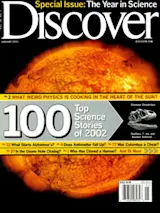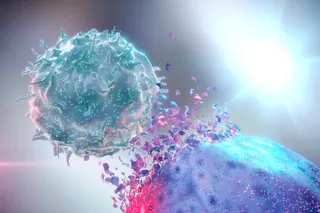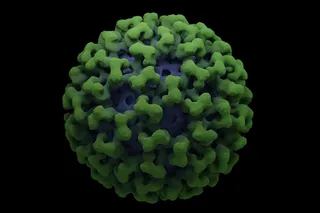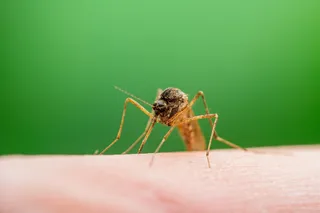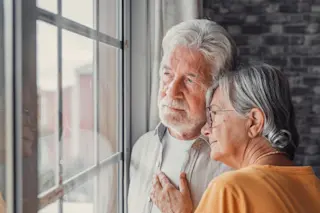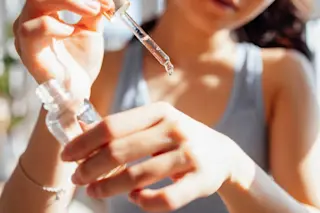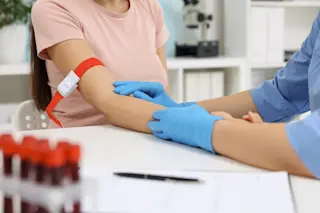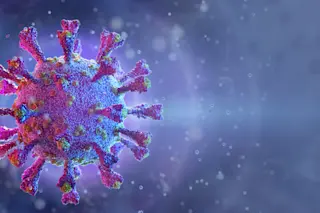33. Biologists Discover Why Most Clones Die Behind every clone that makes it out of a womb alive, there are hundreds of failures. Even in species like cattle, where cloning has become routine, only 4 percent of eggs that have received a transplanted nucleus survive. In May Hans Schöler, a developmental biologist at the University of Pennsylvania, announced he and his team may have figured out one reason why—a gene called Oct4 often doesn't do what it's supposed to do.
When technicians move the nucleus of an adult cell into an egg, the clone will survive only if the egg successfully reprograms the newly installed genes to function as they would in an embryo. Schöler and his team looked at embryonic mouse clones that were just a few days old to see when and where the Oct4 gene—which helps embryonic cells decide where to go and what to do—is active. Subtle changes in the amount or location of Oct4 can drastically misdirect growth. Schöler found that Oct4 was active in the wrong place, at the wrong time, or at the wrong level in about 90 percent of embryos cloned. He also noticed another problem: In natural embryos, both copies of Oct4 are switched on at the same time; but in most cloned embryos, one or both copies of Oct 4 may be randomly inactive.
Because cloning is still an inexact technology, Schöler questions both the value and the morality of using it to create humans: "You can do reproductive cloning only if you are willing to do cloning by statistics: cloning 100 organisms to get one that is OK—or might be OK—and you forget the other 99." However, he believes that cloning embryos for the purpose of making medically useful tissues from embryonic stem cells is still a supportable strategy. Although the transferred nucleus isn't adequately reprogrammed to make an animal, it can be tested to see if it functions well enough to make a line of stem cells. — Rabiya S. Tuma
2002 The Year of Cloning
As a species, we crossed into a new dimension this year, one we will never be able to retreat from: We have developed the science and technology of cloning to the point that reproducing a human is undoubtedly already in progress. There may be dozens of laboratories around the world that now have the knowledge, the equipment, and the skill to clone you. And hundreds, if not thousands, of volunteers are lined up. This is not only the most important science story of 2002, it may be the most important science story of the century.
1. Being Brave for This New World
"There is every indication that 2002 will be the year of the clones," said Panos Zavos, boldly. A reproductive specialist from Kentucky, Zavos made the prediction this past May in a hearing before a congressional subcommittee investigating the issue of cloning humans.
By the time you read this, the prediction might have come true. A cloned human being, a near-replica of another person, may be gestating in a womb somewhere or may even have been born. Zavos himself is openly trying to produce a human clone, and he is not alone. In July, for example, a group called Clonaid said it had a surrogate mother carrying a clone in South Korea. An Italian physician made a similar claim.
These practitioners are willing to work in the public glare. Surely other researchers are trying in secret, and still others are cloning and sustaining human embryos without bringing them to term. The world doesn't want a human clone, yet the world is going to have one, whether it is outlawed or sanctioned, hidden or announced, damaged or healthy. "This genie is out of the bottle," said Zavos to Congress, "and it keeps getting bigger by the hour."
The image of the genie, sprung from a glass container and growing like an unfettered fetus, is an apt metaphor. There are three hardheaded reasons to believe that this genie is not a fantasy.
The first factor is the growing supply and demand for what are called assisted reproductive technologies. The United States has approximately 370 in vitro fertilization clinics, where egg and sperm are brought together in a dish and then implanted in women with fertility problems. To support such services, there is a market in human eggs (women are paid several thousand dollars for eggs harvested from one cycle) and in wombs rented from surrogate mothers. In 1999 about 170,000 babies owed their existence to in vitro methods; probably about 100,000 embryos remain frozen in reserve.
Practitioners of this art have managed to resist government oversight by highlighting the desperation of the couples who want babies. But the success of an in vitro procedure is far from guaranteed, especially when the mother is in her mid-thirties or older, so cloning one of the parents may be their final hope for having a child with a biological tie. Zavos says he has a waiting list of 5,000 couples who will take the plunge. An exaggeration? The point is that any fertility clinic has the paying clientele, the raw biological material, and the unregulated opportunity to produce a clone.
The second factor is the accelerating understanding of cloning within academic laboratories. Embryologists who are appalled at the idea of reproducing a human have nonetheless polished the techniques with animals.
Since 1997, seven mammals have been cloned: sheep, cow, mouse, goat, pig, and, just this year, rabbit and cat. Although Dolly, the sheep, was the first to be created from the cell of an adult mammal, years earlier scientists managed to replicate frogs and cattle at the embryonic level. The original cloning method was to split embryos, a process that mimics the way nature makes identical twins. Then scientists discovered they could transfer nuclear material (the DNA contained in chromosomes) from cells of an embryo to an egg whose own nuclear core had been sucked out. It's kind of like sucking the yolk out of a chicken egg and replacing it with a different yolk from another hen. With coaxing and luck, the egg develops into a genetically identical embryo.
The object of the transfers was not to make animals. The embryos were not for implanting in uteruses but were tools for other studies. In some laboratories, the purpose was to track how nascent organisms develop. In other cases, the goal was to establish a line of embryonic stem cells.
One of the wonders of the mammalian embryo is that when it grows to the stage of a blastocyst, about 100 to 200 cells, a portion of the cells can be collected and maintained indefinitely as stem cells. These cells in turn have the potential to develop into any tissue, which means they might eventually be harnessed to grow, say, a new heart. Moreover, if embryonic stem cells were cloned from the patient, he or she wouldn't have problems with immunological rejection of the cultured tissue. In 2001 human embryonic stem cells spawned their own political imbroglio when the federal government blocked scientists from using public funds to create new stem-cell lines.
The possibilities are mazelike. The thread to follow here is that the invention of nuclear transfer technology—the means to move genes between cells and also backward in time—started the countdown to human reproductive cloning. From embryo cloning, it has led to an adult clone of an adult animal, and then to breakthroughs with additional species. Even if there were no demand, the human knockoff would be next, thanks to the relentless pace of science.
The third factor enabling a human clone—a force stronger than the fertility clinics and university labs—is the biotechnology business. Industrial agriculture has grabbed on to cloning big-time in order to generate superior specimens of livestock. Agricultural and pharmaceutical interests are making animals carry human genes and cloning the results. We can foresee cloned herds as living factories: Cows and pigs will churn out valuable human proteins in their milk or blood, and tissues and organs for transplantation.
On the domestic front, the death of Boots or Fido will lose its sting. Already a company in Texas is preparing to clone your pet cat. Although some of these applications will be profound and others self-indulgent, the bottom line is that biotechnology is building a well-funded infrastructure that, with a few twists of the dial, can manufacture a person.
We are well down the slippery slope. The metaphor has become so common that it cuts both ways. Gregory Stock, who directs the program on medicine, technology, and society at the University of California at Los Angeles school of medicine, says in his new book, Redesigning Humans: Our Inevitable Genetic Future: "[T]he slippery slope has been used time and again to oppose all kinds of innovations. But if biological manipulation is indeed a slippery slope, then we are already sliding down that slope now and might as well enjoy the ride." Stock prefers to imagine a slippery sidewalk. "Rather than sliding uncontrollably into some deep abyss, we more likely will take a spill or two, get up, brush ourselves off, and continue cautiously on our way."
The rough slide to a human clone will be due to the low percentages of the methodology. The majority of nuclear transfers in animals don't take, or they produce fetuses that abort at high rates, or they deliver creatures misshapen and sick. In addition, the genes of cloned mice appear to switch on and off in unique patterns, not matching those of the genetic donor. The process of cloning is both wondrously high-tech and crudely hit-or-miss. That's why many biologists believe reproductive cloning of human beings is unethical. Still, many medical researchers insist that the cloning of human embryos continue because the tissue derived from stem cells might treat diseases ranging from diabetes to Parkinson's. Some may even accept full-blown cloning if safety, health, and efficiency can be improved.
Of course, the slipperiness of the slope depends on our views about the beginning of human life and the propriety of experimenting with it. Those are social and ethical values, which a democracy can convert to legislation. However, the United States has no law against human cloning, because Congress has not agreed where the line should be drawn. Therefore the momentum toward a clone is unchecked.
As we steel ourselves, it helps to keep in mind the following:
1. A clone isn't a freak. Think of him or her as a delayed identical twin, advises Gregory Stock. In short: Cloning is new, but we can get used to it. "Vaccines, antibiotics, organ transplants, and test-tube [in vitro] babies were each initially viewed as unnatural," Stock says.
2. A clone isn't really a clone. The genetic copy is not exact, because something called mitochondrial DNA, separate from the nucleus, remains in the egg receiving the transfer. The clone and the original share only 90 percent of their total DNA, except in the unlikely instance that a mother has herself cloned using one of her own eggs. Anyway, factors other than DNA influence organisms. The cat cloned in 2002 is a different color from its genetic parent.
3. The slippery slope is a misnomer. The problem is not about increasingly harmful developments in science that are contrary to our values but about a lack of understanding of science and its applications. To focus solely on the ethics of cloning is to turn a blind eye to the economic and medical demands for the technology, which are values in their own right. When the full spectrum of our wants and needs is clear, society knows when things have gone too far. When our values are fuzzy and conflicting, we deserve to yield to the human clones. — Jeff Wheelwright
32. Natural Pacemaker In Heart?
Patients with problematic heartbeats might someday get a shot of genetically modified cells instead of a pacemaker. In September doctors at Johns Hopkins University reported they had coaxed cells in a guinea pig's heart to take on the job of regulating the heartbeat.
In healthy hearts, a few thousand cells in two key locations trigger electrical pulses that spread to the remaining cells, signaling them to contract and make the heart beat. When those pacemaker cells die or stop working, the heart won't beat unless it receives an electrical shock from a pacemaker.
Cardiologist Eduardo Marbán and his colleagues realized, however, that pacemaker cells aren't much different from other heart cells; they just have more potassium, which induces the electrical signal. If they could engineer regular heart cells to retain more potassium, they suspected the cells might set off a heart contraction.
Marbán and his colleagues knew of a genetic defect that could disrupt construction of one of the channels that discharges potassium from cells. So they inserted the defective gene into a cold virus and injected it into selected heart cells of guinea pigs. In about 40 percent of the animals, the virus changed the genetic code of the infected cells, closing the potassium channels and converting those cells into functioning pacemakers. — Jeffrey Winters
72. Count Your Genes
The pufferfish, rice, the malaria parasite Plasmodium falciparum, and the mosquito that carries it are among the organisms whose genomes were sequenced in 2002. As the list grows, a paradox emerges: The number of genes an organism has bears little relation either to the number of base pairs—the complementary chemical units within the DNA double helix—in its genome, or to its complexity, as shown below. Rice, for example, may have up to 50,000 genes—about the same number of genes as wheat or corn—but its genome is only 1/38 the length of the wheat genome. Similarly, the pufferfish, with about 31,000 genes, probably has as many as a human, but they're housed in a genome one-eighth the length of the human genome. Nobody knows what the junk DNA that lies between genes is for. The pufferfish genome may hold some clues. Biologist Sydney Brenner of the Salk Institute in La Jolla, California, who won a Nobel in 2002 and led the team that did the sequencing, says his next step is to compare it with the human sequence in order to identify regions that have changed little in the 450 million years since the two lineages split. These conserved sections, he says, show which genetic regions are most essential. They are "constancy in the sea of life," he says. — Rabiya S. Tuma
13. RNA Can Be Used To Stop HIV and Polio From Growing
First they sneak into cells. Then they use the cell's "copy machines" to reproduce their genetic material. That's a virus's way of life—and we haven't had much luck stopping them. However, a genetic mechanism could show us how to interrupt the sabotage. Called RNA-interference, it provokes a cell's own enzymes to effectively erase genetic information a virus needs in order to reproduce. In July labs at the University of California at San Francisco, University of Massachusetts Medical School, and MIT reported that they had used RNA-interference to arrest viral replication in cells infected with HIV and polio.
The key lies in double-stranded RNAs, a type of structure not normally found in a healthy cell. A few years ago, researchers discovered that putting double-stranded RNA into a cell prompted the cell to produce enzymes that destroyed any single-stranded RNAs that matched the sequence of the double-stranded RNA. To see if the technique could be used to interrupt viral infections, the teams introduced double-stranded RNA containing genetic sequences from a viral pathogen into a cell infected with that pathogen. The result was just what they had hoped for: The cell turned on its RNA-interference machinery and immediately destroyed the pathogen's RNA, which pretty much put a halt to the infection.
Why cells can be provoked to destroy RNA is not yet understood, and more work needs to be done before the technique can be tested in humans. Raul Andino, a virologist with the UC San Francisco team, warns that their recent experiments "are just the tip of the iceberg. Right now, we have just seen the first cases in which you can show some efficacy. But the fact that the system exists suggests that if we learn more about how it works, we might be able to find ways to use it to our benefit." — Rabiya S. Tuma
64. 'Junk' DNA Has Role
Our DNA looks like a hoarder's closet. If stretched out and strung together, strands from a human cell would span about five feet, yet less than six inches of it would contain genes. The rest consists of segments of repetitive DNA and non-coding stuff long dismissed as "junk." But now that three vertebrate genomes have been sequenced—human, mouse, and pufferfish—geneticists are re-thinking their appraisal.
"One of the basic rules of evolution is that which is functional tends to be conserved over time," says Edward Rubin, a geneticist at the Lawrence Berkeley National Laboratory in California. A significant amount of junk DNA proves to be conserved in the genomes of mice and humans.
The function of our junk DNA remains a mystery. One hint came in August, when a team led by biochemist Ramin Shiekhattar at the Wistar Institute in Philadelphia reported that a protein complex responsible for lashing the two copies of each chromosome together just before cell division binds to a repetitive element in the human genome.
Rubin says, "There are jewels in this junk that comparative genomics allows us to pick out. We just aren't sure what the jewels are there for yet." — Rabiya S. Tuma
37. Cat Copied
In February scientists at Texas A&M university reported cloning the first house pet: a gray tabby named CC.
Researchers created CC in partnership with a biotech firm called Genetics Savings & Clone, which plans to offer cloning services to pet owners within a year. After CC's birth, the company received hundreds of calls, both for and against, says spokesperson Ben Carlson. "A lot of people alarmed about cloning believe cloning pets is really the most slippery slope toward cloning humans."
After many attempts, CC was created by coaxing the nucleus of a cell from a calico cat into an enucleated egg; an electrical spark prompted the hybrid to divide, and the resulting embryo was then transferred into a surrogate mother. The team performed 188 nuclear transfers to produce 87 cloned embryos. Eight of the embryos were implanted in surrogate mothers, and one led to a live birth. The group has tried to clone dogs, but canine reproductive physiology has proved to be complex.
CC's appearance shows that clones are not exact copies. With her gray fur, CC doesn't even look like the calico cat that donated her genes. Coat color is determined by a poorly understood process that randomly inactivates certain genes in the cells of a developing embryo. The process of gene inactivation is thought to be a phenomenon of all mammals, including humans.
Genetic Savings & Clone warns that pet owners may be expecting more than cloning can deliver. Carlson says: "We have gone to great pains to emphasize that a clone is a brand-new animal, without any of the memories of the old one. It's not going to be a reincarnation of Fluffy." — Francesco Fiondella
25. Radiation Damage Lasts Generations
Even brief exposure to high radiation released from nuclear power plants or from bomb testing deranges DNA for generations to come, says Yuri Dubrova, a geneticist at the University of Leicester in England.
Dubrova and his colleagues exposed male mice to a short pulse of radiation at least 20 times the amount in an ordinary medical X ray, then mated them with unexposed females. Next, they mated the first-generation offspring with healthy animals. When they looked for mutations in the offspring's eggs or sperm, they found a three- to sixfold increase compared with controls. When the team mated the grandchildren with healthy animals, their offspring still carried a three- to sixfold excess of DNA lesions against controls.
Because the mutations were detected in the poorly understood portions of the genome called junk DNA, nobody knows for sure what the impact may be. The animals appear to be healthy and fertile, but the persistence of mutations over three generations means that radiation fundamentally altered the genome.
If the same thing happens in humans, the full effects of accidents like Chernobyl, above-ground atomic tests, and the bombings of Hiroshima and Nagasaki won't be known for generations. Dubrova's team has found elevated mutation rates not only among people affected by Chernobyl fallout but also in a population in Kazakhstan that was downwind of Soviet atomic tests. Also, a 1990 study found a higher risk of leukemia and lymphoma among children whose fathers had been exposed to radiation on the job at a nuclear power plant in West Cumbria, England. — Rabiya S. Tuma
• 15. Polio Can Be Made From Scratch
Now that polio has been nearly wiped from the face of the earth, a team at the State University of New York at Stony Brook has shown that the virus can easily be assembled from scratch in a laboratory, raising fears of bioterror possibilities.
Anyone can find the sequence of the polio genome—a mere 7,500 nucleotides—on the Internet. Eckard Wimmer, a microbiologist and chemist, used the information to patch together more than 100 smaller bits of DNA that can be easily purchased from a made-to-order-DNA company. As he joined one segment to the next, Wimmer made tiny alterations that would distinguish his virus from the real thing. "We changed the genome in order to avoid scratching our heads in the end, saying, 'Did we actually synthesize this virus or was that a laboratory contamination?'"
Wimmer was left scratching his head anyway because the genetic markers had an unintended consequence. Although the faux virus thrived in a tissue culture, it didn't do as well as a naturally occurring poliovirus when it was injected into the brains of mice. "These are mice that have been genetically engineered to be susceptible to polio," says Wimmer, "but we needed 10,000 times as many viruses to kill one mouse."
The Department of Defense funded the experiment to demonstrate the possible misuse of biotechnology, but Wimmer was surprised by the stir he created. He gave interviews from morning to night for three solid weeks and fended off comments from other scientists. "Some colleagues said it was a simple experiment not worth doing and called it a stunt—a not-so-cheap stunt." Others felt he was giving terrorists a blueprint. Wimmer agrees he has shown that others can build their own poliovirus. But, he says, "it's not something you can cook up in the basement. A well-trained virus laboratory could do it, but it would take them some time. In fact, that's what some people call the wake-up call."
Assembling the genome of a more worrisome virus like smallpox is probably out of the question for now. Polio is a small, simple virus; others are more complex. Nonetheless, "technology is advancing at a fantastic pace," Wimmer says. "In 20 to 30 years, it may be possible." — Michael Abrams
50. French Clone Four Rabbits
Rabbits are more similar to humans than laboratory rats or mice, which explains why Jean-Paul Renard, a developmental biologist at the French Agronomy Research Institute in Jouy-en-Josas, spent the better part of three years figuring out how to clone them. In March he and his team reported that they had cloned four healthy rabbits in 2001. Because many rabbit genes are similar to their human counterparts, manipulating disease genes in rabbits, like the one responsible for cystic fibrosis, may permit researchers to track the disease's onset and better understand what goes awry. Cloning makes it easier to produce genetically customized creatures because changes in the DNA are introduced into only one cell—the cell to be cloned. Cloned transgenic rabbits could also produce drugs or human hormones in their milk.
Paying close attention to the details of a particular species' reproductive biology pays off, says Renard. Tweaking steps in the cloning protocol could lead to success in other hard-to-clone animals, such as rats and monkeys. — Rabiya S. Tuma
94. New 22nd Amino Acid Made Inside Cows
Most cells use 20 different amino acids to build proteins, but some have a flair for invention. The 21st amino acid was discovered in the mid-1970s, and now the 22nd amino acid has turned up in a methane-making microbe that lives in the stomach of a cow. Both of the maverick amino acids involve an alternative reading of the genetic code.
In most cells, the three-base sequence uracil-adenine-guanine is a stop signal that shuts down protein production. But microbiologist Joe Krzycki of Ohio State University in Columbus and his colleagues noticed that the bacterium Methanosarcina barkeri was using this stop sign to make a lysine-like amino acid. Then Krzycki recalled that the 21st amino acid, selenocysteine, is also encoded by a stop signal. X-ray crystallography confirmed that he had discovered a new amino acid, which he named pyrrolysine.
So far, pyrrolysine has been detected only in M. barkeri and one other bacterium, but Krzycki expects it will be found in many different species. — Rabiya S. Tuma
36. Have a (Pig) Heart
In January the team that helped clone Dolly the sheep revealed another distortion of nature: five genetically modified cloned pigs. PPL Therapeutics is betting that hearts and other organs from pigs can be transplanted into humans. About the same time, another group at the University of Missouri reported a similar cloning of miniature swine.
Some 16 Americans die every day waiting for a transplant donor. Scientists believe pigs are the most likely candidates for xenotransplantation because their organs are biologically similar to those of humans. The biggest obstacle has been rejection by the human immune system.
In the new piglet clones, a gene that codes for a sugar on the surface of cells has been turned off. "Blocking production of this sugar has been the Holy Grail of xenotransplantation, because the molecule causes a hyperacute rejection within the first two or three minutes of putting a pig organ or cell into a human or primate," says PPL Therapeutics spokesperson David Ayares.
Knocking out one gene, however, doesn't mean the body will accept a new organ. "We need to have strategies for T-cell-mediated, or chronic, rejection," Ayares said, which usually occurs within a few days after transplantation. That will involve adding human genes to the DNA of a pig clone so its organs will look more familiar to a human immune system. And researchers still have to worry about pig viruses that could be transplanted into humans along with the organs. PPL intends to begin trials in primates in the next six to 12 months. — Francesco Fiondella
17. Gene Therapy Halted When Boy Develops Cancer
In April 2000, pediatric immunologist Alain Fischer at Necker Hospital in Paris announced that he and his team had successfully installed a gene that restores normal immune function in three baby boys with a rare genetic illness. The disease, called X-linked Severe Combined Immune Deficiency disorder, cripples a key immune cell and leads to fatal infections. Then in August 2002, one of the treated boys developed a leukemialike condition. In September that trial and three other clinical trials for related immune disorders in the United States were suspended. Subsequent tests revealed that the retrovirus used to ferry the corrective gene into the DNA of blood-making cells in the bone marrow had lodged in or near a gene that regulates T cells, possibly prompting their uncontrolled growth.
The boy was treated with chemotherapy and is reported to be responding well. Factors other than gene therapy—cancer in the boy's family history and a recent bout with chicken pox—may have helped the condition develop. Nonetheless, the result has renewed concern about the oversight of clinical trials for gene therapy. After meeting in mid-October, the FDA's advisory committee recommended that the American trials be resumed and that patients be told that the retrovirus had induced cancer in one child. The agency also asked that trial sponsors inform any patients who have received similar treatments of the adverse result.
"We've known that this was a hypothetical risk," says Donald Kohn, a pediatric immunologist at Children's Hospital in Los Angeles. He leads one of four clinical trials for Severe Combined Immune Deficiency disease in the United States. "What we don't know is the frequency that we would be seeing in patients treated with this therapy." The boy in the French trial "was one out of 10 in the trial. Eight others are doing well—at least as well as with other treatments at this time." The disorder affecting the French boy can be treated only with bone-marrow transplants, and suitable donors are often unavailable. The disorder Kohn is working on can be treated with drugs costing about $300,000 a year.
Nearly 80 clinical trials have attempted to correct faulty disease-causing genes, but only treatments for inherited immune-deficiency disorders have shown any success. In light of the French report, Kohn's group is modifying the consent form for their trial so that families will know before enrolling that adverse effects are possible. They are also developing assays to detect the problem in DNA. "We don't yet know the risks and benefits of this treatment," Kohn says. "The only way to know is to cautiously proceed with other patients." — Sarah Richardson
35. Researchers Create Genetically Modified Cows that Make Human Antibodies
Could a cow save you from hepatitis, West Nile virus, or antibiotic-resistant bacteria? All three infections can be treated by transfusing a patient with plasma containing antibodies from a survivor of the illness. Thousands of patients each year receive antibody treatments for such ailments as autoimmune disorders, hepatitis, and tetanus. But antibodies are scarce, and they carry the risk of contamination by unrecognized pathogens. So researchers at Hematech in Sioux Falls, South Dakota, with funding from Kirin Brewery's pharmaceutical division, are trying to make animals into antibody factories. In August they reported the birth of four cloned calves that are genetically equipped to make human antibodies.
The first step was to insert an artificial chromosome containing the cumbersome human antibody gene into the nucleus of a cow cell. Then they used the same technique, more or less, that created Dolly, the cloned sheep. James Robl, the team's leader, says that adding the genetic material before the cell is cloned is easier than trying to get that material into an egg that has already been fertilized. The problem now is perfecting the cloning procedure so it doesn't require hundreds of attempts to yield a handful of offspring. Nonetheless, Robl thinks the procedure will have tremendous payoffs. "With cows, we can immunize them with hepatitis C, Ebola vaccine, or whatever you like and be able to produce high titer responses," he says. The antibodies could then be harvested from either milk or blood.
So far, Robl has more than two dozen transgenic cloned calves making human antibodies. The next step, he says, is to knock out the cows' own antibody genes, so they will produce only human antibodies. Then researchers must make certain the antibodies are free of viruses. Robl thinks antibodies from cows could be available for use in about two years. — Rabiya S. Tuma
73. Priorities Set For Genome Sequencing
With the sequence of the human genome nearly complete, the National Human Genome Research Institute had to decide this year what other organisms merited a taxpayer-funded readout. In two rounds of reviews, the group considered 25 briefs, each arguing the merits of a particular organism. By fall the council had awarded top priority to all but two. Among the winners were:
• The chicken: important not only for agricultural research but also as a common model for embryonic development • The chimpanzee: close relationship to humans can provide insights into diseases and cognition • The cow: for agricultural development • The dog: a well-established medical model • Fifteen Fungi: useful for basic biology, evolutionary studies, and medical treatments • The honeybee: for studies of instinctive social behavior and for agricultural research • The sea urchin: a model for developmental biology
Trichoplax adhaerens, a member of a group of species that lies between fungi and higher animals on the evolutionary tree, and the rhesus macaque, commonly used in medical research, received lower priorities.
The most contentious decision was to give the chimpanzee higher priority than the rhesus macaque. Although the chimpanzee shares at least 95 percent of our DNA—making it our closest relative—it is not used in medical research nearly as much as the macaque, which has been the subject of thousands of behavioral and medical studies.
A high priority ranking doesn't guarantee sequencing soon. Only when major projects on the human, the mouse, and the rat are complete will the three main government-sponsored sequencing centers take on new projects. — Rabiya S. Tuma


